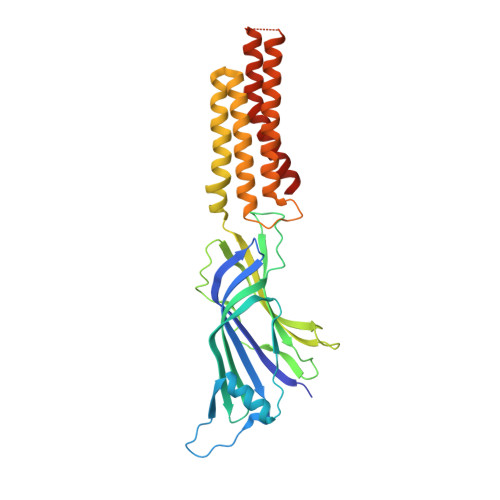Crystal structures of a pentameric ion channel gated by alkaline pH show a widely open pore and identify a cavity for modulation.
Hu, H., Nemecz, A., Van Renterghem, C., Fourati, Z., Sauguet, L., Corringer, P.J., Delarue, M.(2018) Proc Natl Acad Sci U S A 115: E3959-E3968
- PubMed: 29632192
- DOI: https://doi.org/10.1073/pnas.1717700115
- Primary Citation of Related Structures:
6FL9, 6FLI, 6FVQ, 6FVR, 6FVS - PubMed Abstract:
Pentameric ligand-gated ion channels (pLGICs) constitute a widespread class of ion channels, present in archaea, bacteria, and eukaryotes. Upon binding of their agonists in the extracellular domain, the transmembrane pore opens, allowing ions to go through, via a gating mechanism that can be modulated by a number of drugs. Even though high-resolution structural information on pLGICs has increased in a spectacular way in recent years, both in bacterial and in eukaryotic systems, the structure of the open channel conformation of some intensively studied receptors whose structures are known in a nonactive (closed) form, such as Erwinia chrysanthemi pLGIC (ELIC), is still lacking. Here we describe a gammaproteobacterial pLGIC from an endo-symbiont of Tevnia jerichonana (sTeLIC), whose sequence is closely related to the pLGIC from ELIC with 28% identity. We provide an X-ray crystallographic structure at 2.3 Å in an active conformation, where the pore is found to be more open than any current conformation found for pLGICs. In addition, two charged restriction rings are present in the vestibule. Functional characterization shows sTeLIC to be a cationic channel activated at alkaline pH. It is inhibited by divalent cations, but not by quaternary ammonium ions, such as tetramethylammonium. Additionally, we found that sTeLIC is allosterically potentiated by aromatic amino acids Phe and Trp, as well as their derivatives, such as 4-bromo-cinnamate, whose cocrystal structure reveals a vestibular binding site equivalent to, but more deeply buried than, the one already described for benzodiazepines in ELIC.
Organizational Affiliation:
Unité Dynamique Structurale des Macromolécules, Institut Pasteur, UMR 3528, CNRS, 75015 Paris, France.
















